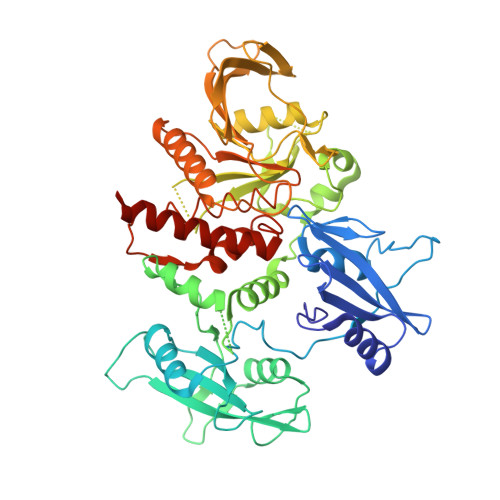Molecular basis of gain-of-function LEOPARD syndrome-associated SHP2 mutations.
Yu, Z.H., Zhang, R.Y., Walls, C.D., Chen, L., Zhang, S., Wu, L., Liu, S., Zhang, Z.Y.(2014) Biochemistry 53: 4136-4151
- PubMed: 24935154
- DOI: https://doi.org/10.1021/bi5002695
- Primary Citation of Related Structures:
4OHD, 4OHE, 4OHH, 4OHI, 4OHL - PubMed Abstract:
The Src homology 2 (SH2) domain-containing protein tyrosine phosphatase 2 (SHP2) is a critical signal transducer downstream of growth factors that promotes the activation of the RAS-ERK1/2 cascade. In its basal state, SHP2 exists in an autoinhibited closed conformation because of an intramolecular interaction between its N-SH2 and protein tyrosine phosphatase (PTP) domains. Binding to pTyr ligands present on growth factor receptors and adaptor proteins with its N-SH2 domain localizes SHP2 to its substrates and frees the active site from allosteric inhibition. Germline mutations in SHP2 are known to cause both Noonan syndrome (NS) and LEOPARD syndrome (LS), two clinically similar autosomal dominant developmental disorders. NS-associated SHP2 mutants display elevated phosphatase activity, while LS-associated SHP2 mutants exhibit reduced catalytic activity. A conundrum in how clinically similar diseases result from mutations to SHP2 that have opposite effects on this enzyme's catalytic functionality exists. Here we report a comprehensive investigation of the kinetic, structural, dynamic, and biochemical signaling properties of the wild type as well as all reported LS-associated SHP2 mutants. The results reveal that LS-causing mutations not only affect SHP2 phosphatase activity but also induce a weakening of the intramolecular interaction between the N-SH2 and PTP domains, leading to mutants that are more readily activated by competing pTyr ligands. Our data also indicate that the residual phosphatase activity associated with the LS SHP2 mutant is required for enhanced ERK1/2 activation. Consequently, catalytically impaired SHP2 mutants could display gain-of-function properties because of their ability to localize to the vicinity of substrates for longer periods of time, thereby affording the opportunity for prolonged substrate turnover and sustained RAS-ERK1/2 activation.
- Department of Biochemistry and Molecular Biology, Indiana University School of Medicine , 635 Barnhill Drive, Indianapolis, Indiana 46202, United States.
Organizational Affiliation:
















